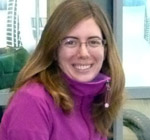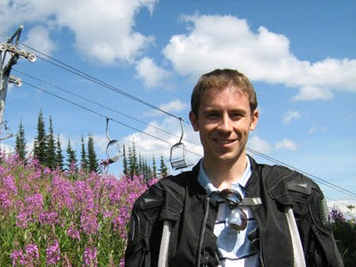Alumni
The Master of Spatial Analysis has an increasing number of alumni who lead spatial data management, analysis, and visualization in the workplace across sectors and industries. Although every career path will be different, we provide examples of alumni careers below.
If you are an alumna or alumnus of the MSA program, please get in touch with the program director via spatial@torontomu.ca.
If you have a facebook account, please request an invitation to the “MSA Network” at https://www.facebook.com/groups/58055468529/ (external link) . This is a closed group set up to facilitate the networking and sharing of program- and employment-related information between alumni, and with current students and program faculty.

Anna Banaszewska (MSA ’09) works as a GIS Analyst with the Queen's Public Health Informatics Group based at KFL&A Public Health in Kingston. Her current projects include geo-enabling multiple public health dataset, traditional cartography & FLEX interactive mapping, spatial pattern recognition and hotspot analysis, and data fusion for real-time monitoring and evaluation. She has also taken a role in enhancing the health unit's contributions to community-based projects by collaborating with partners such as the Public Health Lab, United Way, City of Kingston and Queens University. Before entering the MSA program as a full-time student, Anna had completed a Bachelor in Environmental Studies and a Certificate in GIS and Remote Sensing from York University. Her MSA research paper, “A Spatial Investigation of Photosynthetically Active Radiation and its Role in Natural Regeneration of Quercus Rubra: A Case Study of Kew Gardens Park, Toronto” allowed her to develop and enhance her skills in sampling design, field data collection, data normalization and geostatistical analyses. Anna's first job after graduation from the MSA program was that of a GIS Technical Specialist for Simcoe Muskoka District Health Unit in Barrie, where she developed and implemented a centralized GIS for public health and emergency response. Quoting Anna: “The skills you learn in the MSA program: spatial analysis, statistics, or geovisualization, are so versatile -- you can truly take them into any field of work!”

Erin Vandahl (MSA ’08) held a Bachelors degree in Education from Lakehead University when she was entering the Master of Spatial Analysis. “I was looking to make a career change and wanted a post-graduate program that would build a highly desirable and marketable skill set within a short period of time. The MSA program provided just that with its strong emphasis on spatial statistics and several practical experiences that allowed me to make a seamless transition between careers. Completing my MSA was the best career move I’ve made.” Just prior to graduation, Erin was hired by the Waterloo Regional Police Service as a Research Analyst and Planner. Erin used her knowledge of database management and data integration to assist with the transition from a standalone GIS solution to one that is fully integrated with the Service’s records management system. The project won ESRI Canada’s Award of Excellence in 2010 for outstanding achievement in the application of GIS technology. Erin also applied her understanding of spatial clustering and geospatial data modeling when coordinating the redesign of the Waterloo Regional Police Services’ patrol zones and divisional boundaries. The boundaries, which had not been updated since the 1970s, are now designed to have equitable demand on police resources while being able to incorporate regional growth over the next several years. The new patrol boundaries form the basis for the Service’s new deployment model of Neighbourhood Policing. Erin is looking forward to applying more of the geostatistical analysis skills she learned at Ryerson as the Waterloo Regional Police Service further develops predictive analytics and GIS is increasingly used as a corporate management system.

Elspeth Evans (MSA ’07) came to Ryerson with a BSc in Physical Geography and GIS from Queen's University. She started working part-time for Oxford Properties Group while completing her MSA research paper on retail trends in two urban regeneration districts in downtown Toronto. Upon graduation, she became a Market Research Analyst at Oxford, where she collaborated with property managers, developers, and investors on analyzing market shares, retail sales, and benchmarks for Oxford’s shopping centres. Recently, Elspeth moved internally to the position of Assistant Property Manager, where she is now helping to manage a large office tower in downtown Toronto. “My experience in the MSA program gave me a strong theoretical background in spatial statistics, while developing practical applications for geographical analysis. The combination of coursework with an external internship provided a ‘real world’ context to problem solving and improved my analytical skills. Ryerson’s corporate connections also allowed me to network with potential employers, which eventually led to my current position.”

Brian Kelsey (MSA ’07) is a Spatial Data Analyst with the Province of British Columbia. His first job after graduation from the MSA was that of a GIS Technician for the National Capital Commission in Ottawa, where he collected, maintained, and analyzed comprehensive geospatial datasets for the federal government. Brian came to Ryerson with a BSc in Physical Geography from Trent University and a GIS Applications Specialist Certificate from Sir Sandford Fleming College. In his MSA research paper on “Usability Analysis of Map-Centred Decision Support: An Application in Community Health Planning”, Brian developed the knowledge to draw upon when developing geospatial tools for government applications. His experience working in a team on a practicum project helped to build strong project management skills. “I found the practical elements of the MSA program to be quite valuable and was impressed with the variety of courses available.”

Craig Onafrychuk (MSA ’07) completed an honours degree in Anthropology at Lakehead University where he studied social cultural anthropology and native studies. After completing the Certificate in Applied Digital Geography and GIS at Ryerson, Craig went on to complete the Master of Spatial Analysis. In his research paper he leveraged an automated index for classifying surface water distribution including areal features such as wetlands, open aquatic areas, as well as the connectivity between these features including ephemeral and permanent streams. While completing his MSA, Craig worked as an Inside Sales Rep at ESRI Canada and moved on to a GIS Analyst position. He then served as the Information and Mapping Coordinator for Kawartha Heritage Conservancy, a locally-based land trust. After graduating from the MSA, Craig took a position at the Ministry of Natural Resources (MNR) as a Fisheries Metadata Officer supporting the Information Management & Spatial Analysis Unit of the Southern Science and Information Section. He is now a Data Analyst with the Water Resources Information Program (WRIP) in the Geographic Information Branch at the MNR. His program provides broad support to provincial water resources applications including provincial digital elevation modelling. In his job he focuses on managing production of the Provincial Borehole Database while providing business analysis support in implementing IT requirements for the Clean Water Act.

Mark Lebovits (MSA ’06) is currently a Senior Associate at Environics Analytics Group. Before Environics he worked at Bell Canada as a manager in the Broadband Strategy Group where he conducted geographical analysis of prioritizing the deployment of the Fibre-to-the-Node infrastructure. He came to Ryerson with a HBA in Economics and Geography from the University of Toronto. Mark’s MSA research paper on “Applying Geographically Segmented Markets to Retail Sales Forecasts” has given him a broader understanding of the retail industry and has allowed him to thrive in his current position where his work is focused on retail and food service clients. Mark attributes his career successes to the practical elements taught in the MSA program. “The spatial statistics knowledge I gained from the MSA program is invaluable – the statistical principles are applied on an ongoing basis at Environics. My analytical skills were utilized quite extensively during my last role at Bell Canada as my work was incorporated into many C-suite level presentations.”

Anthony Spagnolo (MSA ’04) entered the MSA program with an undergraduate business degree from Ryerson with a major in Economics and Management Science. He took a one-year leave of absence from TD Bank to complete the MSA program full time. He completed his MSA practicum placement with TD Retail Real Estate in the Branch Development and Market Strategies department where he built estimation models for the prediction of offices and teller stations in the branch network. In his major research paper Anthony developed a trade area-based store segmentation and subsequently used this model for cluster-based sales estimation. Upon graduation, Anthony returned to TD Retail Real Estate as a Manager within Market Strategies and led the development of a patented method for deriving retail branch trade areas, a web-based Market Intelligence Information System (MIIS), and implemented a branch segmentation system known as Peer Clusters. Anthony now manages the Predictive Modeling and Strategy Development team within TD Personal Lending & Credit Cards and leads the development of customer behaviour models and various customer acquisition and account management strategies. In addition, Anthony is an instructor at Ryerson’s Chang School for Continuing Education where he teaches courses on spatial database management systems and issues and innovations in GIS. “Completing the MSA was one of the most rewarding experiences of my life. The knowledgeable professors and practical course work helped me build upon my existing knowledge of analytics, econometrics and statistics and carve out a niche market for myself within TD Bank. Putting any analysis into a spatial context opens up new angles and possibilities to aid in strengthening business decision-making and yield new opportunities.”